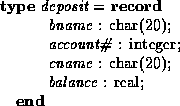Fixed-Length Records



Next: Variable-Length Records
Up: File Organization
Previous: File Organization
-
Consider a file of deposit records of the form:

- If we assume that each character occupies one byte, an integer occupies
4 bytes, and a real 8 bytes, our deposit record is 52 bytes long.
- The simplest approach is to use the first 52 bytes for the first record,
the next 52 bytes for the second, and so on.
- However, there are two problems with this approach.
- It is difficult to delete a record from this structure.
- Space occupied must somehow be deleted, or we need to mark deleted
records so that they can be ignored.
- Unless block size is a multiple of 52, some records will cross
block boundaries.
- It would then require two block accesses to read or write such a record.
-
When a record is deleted, we could move all successive records up one
(Figure 7.6), which may require moving a lot of records.
- We could instead move the last record into the ``hole'' created by the
deleted record (figure 7.7).
- This changes the order the records are in.
- It turns out to be undesirable to move records to occupy freed space,
as moving requires block accesses.
- Also, insertions tend to be more frequent than deletions.
- It is acceptable to leave the space open and wait for a subsequent
insertion.
- This leads to a need for additional structure in our file design.
-
So one solution is:
- At the beginning of a file, allocate some bytes as a file header.
- This header for now need only be used to store the address of the first
record whose contents are deleted.
- This first record can then store the address of the second available
record, and so on (figure 7.8).
- To insert a new record, we use the record pointed to by the
header, and change the header pointer to the next available record.
- If no deleted records exist we add our new record to the end of the
file.
-
Note: Use of pointers requires careful programming.
If a record pointed to is moved or deleted, and that pointer is not corrected,
the pointer becomes a dangling pointer.
Records pointed to are called pinned.
-
Fixed-length file insertions and deletions are relatively simple because
``one size fits all''.
For variable length, this is not the case.



Next: Variable-Length Records
Up: File Organization
Previous: File Organization
Page created and maintained by Osmar R. Zaï ane
Last Update:
Tue Oct 31 12:59:25 PST 1995



